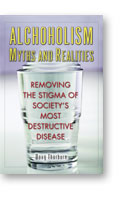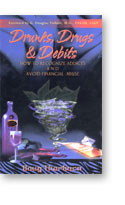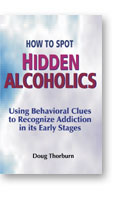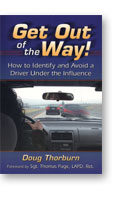|

Evidence offered in Drunks, Drugs & Debits: How to Recognize Addicts and Avoid Financial Abuse suggests that roughly 80% of serially erratic misbehaviors can be explained by alcohol or other-drug addiction. Unfortunately, since addictive use is often hidden from pubic view by enablers, in ratcheting up or down the likelihood that addiction explains poor conduct, we are often stuck at 80%. This is particularly true among CEOs, doctors, lawyers, other professionals--and politicians.
Most celebrities and professional athletes who misbehave are almost always "outed" by journalists. The fact that such behaviors in celebrities who are known alcoholics are similar to those of politicians, etc., in whom heavy drinking is never reported--and for whom enablers abound--is damning evidence that alcoholism is the driving force in both. Since addiction causes egomania (which compels the addict to wield power capriciously), as well as distortions of perception resulting in bizarre or abnormal conduct, such behaviors indicate a high probability of hidden alcoholism.
Detroit Mayor Kwame Kilpatrick is almost universally described as "flamboyant." He sports a diamond earring and "mayor" embroidered on his French cuffs. He ran up $200,000 in spa treatments and champagne on what he claimed was legitimate city business at a time the city was cutting police officers to plug a $250 million deficit. Only a handful of detailed receipts for hotel rooms, airfares and meals support what appear to be tens of thousands of dollars of travel and entertainment, but in at least two instances alcohol was charged to the city's credit card in an apparent violation of city policy. While Kilpatrick's predecessor, Dennis Archer, routinely provided detailed receipts and never stuck taxpayers for any meal over $40, examples of Kilpatrick's extravagances include a $319 charge at Ozio Restaurant & Lounge (chic Art Deco cigar and martini bar catering to celebrities) and $292 at the Capital Grille (panoramic view of the U.S. Capitol with a wine list sporting more than 800 labels) while attending a U.S. Conference of Mayors' winter meeting. Detroit city workers traveling on city business rarely if ever get a dinner paid by taxpayers, but Kilpatrick once enjoyed a bottle of Moet & Chandon Nectar Imperial champagne, four Malibu Rum drinks and three shots of Chambord liqueur at Justin's Restaurant & Bar in Atlanta, the tab for which "far exceeded" the cost of the barbeque shrimp, egg rolls and fritters, all at the city's expense. While former mayor Archer explained his frugality by saying, "The city really had no funds to entertain anybody" during his eight years in office, which according to the Detroit Free Press "included some of the most prosperous times in recent Detroit history," it isn't even clear why Kilpatrick at one point spent $296 on two orders of crab legs, two beers and a tumbler of Glenlivet scotch at Bob Chinn's Crab House in Chicago.
His personal tastes seem to extend to public ones. His plan for the economic revival of Detroit rests on attracting high-profile and flashy projects, including the 2006 Super Bowl, cajoling General Motors, Compuware and Quicken Loans to relocate their offices downtown, and creating three casinos. In the meantime, high school graduation rates hover at around 25%, homicide rates are nearly 50 per 100,000 (Gotham's are 7.3 per 100,000; every other measure of violent crime and theft in New York City are also a fraction of Detroit's) and there seems to have been no attempt to simplify Detroit's third-world-like Byzantine regulations that require day care centers and hair-braiding salons to obtain 70 building and equipment permits by opening day.
The questionable public antics began early in Mayor Kilpatrick's reign. His wife, who is rumored to have "unexpectedly" stopped by a party that reportedly* took place in the mayoral mansion in 2002 to celebrate his election, allegedly took a bat to a stripper whom she found consorting with her husband. The stripper was gunned down a few months later and a lawsuit followed, alleging on behalf of her 14-year-old son that the mayor's office stifled the investigation of her death. Two Detroit police officers, who were summarily fired by the mayor after launching a private probe to investigate rumors of the party and related complaints, won a $6.5 million verdict under a whistleblower lawsuit. A month after he vowed to appeal, Kilpatrick abruptly settled for $1.9 million more than the jury award. Detroit's unwitting taxpayers will pick up the tab notwithstanding Kilpatrick's claim that he has "paid back" the $8.4 million through "hard work for the city."
Shortly after the lawsuit was settled, The Detroit Free Press managed to obtain 14,000 text messages (indicating an extreme case of telephonitis, which is an often excellent if unheralded behavioral clue to alcoholism) from 2002-2003 between Kilpatrick and his former chief of staff, Christine Beatty. In testimony given by both of them during the lawsuit, each denied carrying on an affair. However, the messages included one in which Kilpatrick wrote, "I'm madly in love with you," with Beatty responding, "I hope you feel that way for a long time...I am madly in love with you, too!" and reportedly "steamy" dialogue, along with secret meetings and how to conceal their trysts. Wayne County Prosecutor Kym Worthy has now charged the mayor with obstruction of justice, perjury and misconduct in office. He is charged with attempting to hide the extramarital relationship and official misconduct by coercing and punishing police officials who were investigating the allegations. Both he and Beatty had denied under oath that former Detroit Deputy Police Chief Gary Brown, head of internal affairs, had been fired, while text messages sang a different tune. The pair then attempted to hide the incriminating messages, thereby obstructing justice, because they feared Brown would uncover the affair and other "illegal acts" by the mayor's staff.
Without any further evidence, the odds that alcoholism explains the misbehaviors are on the order of 80%. However, when we learn that since 2002 Washington, D.C. police will no longer provide after-business-hours police protection to Kilpatrick because of "inappropriate partying" because they feel that such "late evening partying...might result in an incident at one of the clubs," we can safely close in on 100% odds of alcoholism.
Abuse of power is by itself a compelling indication of alcoholism. Combined with ostentatious displays of wealth, lying, adultery and extravagance--especially with other people's money--the evidence is overwhelming that Kwame Kilpatrick suffers from the same disease that drives another charismatic politician with a similar aura, former Washington, D.C. mayor Marion Barry. It will be most interesting to see whether Mr. Kilpatrick's future history plays out in similar fashion.
* You'd think it would be easy to ascertain whether or not a party took place. Oddly, while Ms. Greene claimed she was attacked at the party and Detroit cops were fired for investigating allegations of the party, the Republic state attorney general, Mike Cox, found "no evidence" that the party took place. There's much more to this bizarre (and therefore likely fueled by alcoholism) story.
Runners-up for top story of the month:
Actor Wesley Snipes, convicted of three counts of willfully failing to file tax returns and sentenced to three years in prison in the IRS's highest-profile criminal tax case in decades. Insight into Snipes' convoluted thinking, likely rooted in long-term psychotropic drug addiction, can be found in the January 2007 edition of the Thorburn Addiction Report (http://preventragedy.com/pages/TAR/027.jan07.html). There's more, below, under "enabler of the month."
Actor Gary Busey, evicted from his rented Malibu home on which he allegedly owes more than $50,000 in back rent. Busey was last seen in court in 2004 when refusing to pay $52,000 in past-due rents, according to his attorney because of mold in the house. Friends admit that while Busey claims he is refusing to pay this time because "unclean air conditioning vents are posing a health hazard," the truth is he "sometimes spends more than he earns." As pointed out in numerous stories of financial abuse in Drunks, Drugs & Debits, spending beyond one's means indicates an attempt to inflate the ego, which is usually due to alcoholism. I ask tax clients who own rental property on which large sums of back rent are due, "Did you see any indications of alcoholism before the tenant moved in?" Many admit they wondered despite the completely reasonable explanations for having a poor FICO score, or observed what seemed to be a too-charming façade at the start. (When I ask, "How many bottles did you find in the vacated unit that the prior tenant demolished?" they often respond, "How did you know?" or "No bottles, but lots of syringes.") Landlords who want to learn how to prevent such financial abuse and psychological trauma may wish to invest in (and deduct as a business expense) How to Spot Hidden Alcoholics: Using Behavioral Clues to Recognize Addiction in its Early Stages and Drunks, Drugs & Debits: How to Recognize Addicts and Avoid Financial Abuse.
Embittered homeowners, who have been stripping out appliances and wiring, punching holes in walls, dumping paint on carpets and locking their pets inside after vacating foreclosed homes. Reportedly half of foreclosures have "substantial" damage. Recovering addicts attest to having had "unreasonable resentments" while using, which can lead to vindictiveness and revenge. They admit they blamed everyone else for their mistakes. Landlords, when questioned, realize that vacated units with damage almost always were occupied by someone who they would now identify as an alcohol or other-drug addict. I suggested the likelihood in the TAR August 2007 top story, "The Mortgage Mess, the Real Estate Bubble and Alcoholism," that the bubble was fueled in large part by alcoholics, because in the often-manic early stages they feel they are invincible and can be prolific liars. As the anonymous blogger writes, "The vast majority of people 'losing their homes' are not the innocents portrayed in the media or by Hillary Clinton, taken advantage of by 'predatory lenders'. They're just your typical losers, chain smoking at the casino, hoping against hope for 'the big score' that never came. They're gamblers who bet and lost. They're people who committed mortgage fraud...." The fact that as many as half of foreclosures suffer damage not dissimilar to that wreaked on rental properties provides additional support for the idea that the bubble was fueled by alcohol and other-drug addiction--and now made worse by addiction as entire neighborhoods suffer from the blight of vacant and damaged homes.
Bob Timmins, no ordinary addiction counselor, dead from chronic obstructive pulmonary disease at 61. According to Rolling Stone, Timmins "used his own struggles with drugs and alcohol to help a generation of rock stars" including Kurt Cobain, Scott Weiland and members of Motley Crue, Guns n' Roses and Aerosmith. Timmins is a wonderful contrary example for those who say "my addict will never get sober." He dropped out of the ninth grade and, living on the street much of the time, spent eight years in and out of prison on robbery and drug-related charges before a public defender got him into a twelve-step program. He was able to honestly claim, "Nobody's been down farther than me," which helped his credibility when dealing with practicing addicts whose lives had fallen apart. He became a titan in the world of recovery and, according to his friend, attorney Michael Nasatir, helped clean up "owners of sports franchises to heads of movie studios to Grammy-winning, internationally known music idols...as well as the most down and out homeless person..." He served as an expert witness in courts across the country and as a consultant in the development of treatment plans for offenders. Superior Court Judge Bernard Kamins (also a drug court judge) said, "The amount we paid him [for his expertise in selecting a proper program for a defendant] was a joke compared to what he did." Bob Timmins will be missed by many who knew him and even more by those who never had the opportunity of benefiting from his counsel.
Under watch:
Former New York Governor Eliot Spitzer is one of the many top law enforcers in whom we have no definitive proof of alcoholism but whose behaviors indicate this disease. The key hallmark of hidden early-stage alcoholism, egomania, has been evident in Spitzer for years. Proving alcoholism in an influential politician in whom no one suspected it could break the budding field of addiction identification based on behavior patterns wide open. It is in the hope that Mr. Spitzer might be that "someone" that previous observations are recounted.
From the May 2005 issue of the Thorburn Addiction Report:
"New York State Attorney General Eliot Spitzer, publicly airing charges of fraud by former AIG CEO Maurice 'Hank' Greenberg, not only before charges have been brought, but also before the investigation is even finished (reminiscent of alcoholic Senator Joe McCarthy's false accusations in an era of McCarthyism)."
From the July 2005 issue:
"New York Attorney General Eliot Spitzer, finally confronted in the courtroom by one of his business targets, former Bank of America broker Theodore Sihpol, in a match reminiscent of David and Goliath. The jury found Sihpol's after-market-close trading, which Mr. Spitzer called criminal, to be commonly accepted practice. Sihpol was acquitted on 29 counts, with the jury hung on four others, for which a single juror held out for conviction. Sihpol had refused a plea offer that included jail time, putting himself at risk for a 30-year term. Other business targets have caved into Spitzer's prosecution-by-press-release and threats of indictment or the destruction of an entire company, paying enormous fines (often with shareholder funds). None had previously risked a trial."
And in November 2005:
"New York Attorney General Eliott Spitzer, who continues to devote multiple lawyers to his case against the New York Stock Exchange over former Exchange President Dick Grasso's compensation package, while claiming his office is too low on funds to pursue Medicaid fraud (Medicaid consumes $40 billion yearly in New York). One of the directors of the Exchange compensation committee, Ken Langone, explains that if his office prevails (which it likely won't), the damages would be handed back to the owners of the Stock Exchange, 'millionaires one and all--myself included.' Langone, who was smeared by Spitzer as 'unsavory' and 'deceptive,' and whose heart Spitzer pledged to 'put a stake through,' points out that Spitzer has a 'troubling method of making loud legal threats, strong-arming witnesses, and intimidating boards and companies into destructive concessions.' The use of hyperbole, intimidating others and the need to destroy worthy people are superb behavioral indications of alcoholism."
Eliot Spitzer has repeatedly displayed indications of alcoholism by abusing power. A married man with three teenage children, he has now been caught doing something that may be described as bizarre, immoral, disgusting and incredibly stupid: he was discovered to have paid thousands of dollars for hookers on multiple occasions. This is the same man who went after prostitution rings while he was Attorney General. Those who shake their heads and wonder about the notable hypocrisy might benefit from listening to recovering addicts, many of whom admit that adultery, including the use of prostitutes, would have been an everyday occurrence when using if only they had the time. They also tell those of us who listen that despite repeated promises to never do "it" again, whatever "it" was, they began drinking and "it" happened again and again. "It" includes adultery and the use of prostitutes.
As usual, we'll give Mr. Spitzer the benefit of the doubt: he got drunk and decided to make false accusations. He got drunk and decided to inflate his ego by doing everything in his power to convict innocent people. He got drunk and displayed an inordinately large sense of self-importance by sanctimoniously telling others they would pay dearly for violating the law. He got drunk and paid for a hooker, in violation of both the law, his marriage contract and everything he stood for publicly. Alcoholism is by far the best explanation for Eliot Spitzer's megalomania and, now, gross stupidity. It doesn't excuse his behaviors, but it does explain them. And it points to the solution.
Helen Golay, 77 and Olga Rutterschmidt, 75, convicted of murdering two homeless men for $2.8 million in life insurance. In a carefully plotted scheme, the women picked the men off the streets, purchased numerous small insurance policies on them (keeping off insurers' radar), paid for apartments for the two years--the period after which insurers generally cannot contest a policy--and either ran them over or had them run over in dark alleys. The women were allegedly partners in a number of bogus lawsuits before trading up to murder in the late '90s. Let us assume alcohol or pharmaceutical drug addiction explains their horrific behaviors. Instead of being given the opportunity to get clean and sober a few decades ago and living clean, sober and honest lives, they will live out their golden years in the clinker.
Orange County, California Deputy Sheriffs, who allegedly lied, fabricated stories and even compared notes after being ordered not to discuss the case by a grand jury investigating a deadly beating at Theo Lacy Jail. During 45 days of questioning, members of the Sheriff's Department hindered the probe to a degree the likes of which have rarely become so publicly obvious, with then-Sheriff Michael S. Carona leading the fray. Carona, who qualified for Top Story in TAR's November 2007 issue, refused to answer a single question, including whether he was the county's sheriff on the day John Derek Chamberlain, a computer technician held on suspicion of possessing child pornography, was beaten by fellow inmates over a 50 minute period. According to grand jury transcripts, Deputy Kevin Taylor, who sat nearby, watched television and exchanged 22 cell phone text messages with friends while the beating took place. Special Officer Phillip Le, who was on duty with Taylor during the attack, testified he recorded over the first seven to 10 minutes of videotape of the scene after guards discovered Chamberlain's body. Sheriff's officials stymied the grand jury at every opportunity, even refusing to produce simple Sheriff's Department policy manuals without a legal battle. Prosecutors were told that Taylor's background file was missing, but managed to find he had been the subject of at least two internal affairs investigations for allegedly beating inmates. An assistant sheriff overseeing the department's background files, Dan Martini, testified that the disappearance of the files made no sense and that he was considering bringing in the state attorney general's office to investigate, but was removed from his position by Carona two days before he appeared before the grand jury.
Orange County, California Deputy Sheriffs (yes, them again), one of whom reportedly used a Taser stun gun on a cat at Theo Lacy Jail. The cat's corpse was found on jail grounds. Animal abuse, like human abuse, is almost always rooted in alcohol or other-drug addiction. As pointed out in Drunks, Drugs & Debits, 20% to 50% of law enforcers have the disease of alcoholism, which means they will abuse others some of the time. This is why law enforcers--especially Orange County sheriffs--should be randomly and regularly screened for signs of alcoholism, which would include testing at over .03 per cent blood alcohol level at 8 a.m. (which converts to a BAL of at least .15 per cent at midnight)--at home or on the job.
Co-Dependent of the Month:
Jamie Spears, pop star Britney Spears' dad, giving in to her tirades by letting her drink wine with dinner "as a way to relax" and because the young, tragic alcoholic convinced Jamie that "a steak dinner isn't complete" without a glass of red wine. Reportedly, when her mother Lynne asked Britney if she was drinking, she responded, "Daddy said I could. It's just wine." Message to Jamie: while a glass of wine can be a "way to relax" to a non-addict, it is an open invitation to begin a full-blown relapse to an addict.
Enablers of the Month:
Family members, friends and fellow actors Woody Harrelson and Denzel Washington, who attested to actor Wesley Snipes' "compassion, intelligence and value as a mentor" in letters to the court asking for leniency at Snipes' sentencing, where he was given three years in prison on three counts of misdemeanor failure to file tax returns (incredibly, he was acquitted on felony charges of tax evasion). Such comments stand in stark contrast to those made by journalist Chris Parry, who recounts a day on the set of "Blade: Trinity" in a piece entitled, "Drugs, Stand-Ins, Mood Swings and Legal Action: The Real Wesley Snipes," describing Snipes as a "drug-affected, moody, uncooperative piece of garbage, masquerading as an actor while all [those] around him tried to cover up for his shitty attitude." Snipes' trial was the most celebrated tax fraud case since Leona "only little people pay taxes" Helmsley was convicted on charges of tax evasion in 1989 (see the September 2007 TAR for more on her).
The St. Louis Cardinals, which signed third-baseman Scott Spiezio for a two-year $4.5 million contract after the 2006 season despite, well, a behavioral history that is as outrageous as that of Britney Spears'. After gaining folk-hero status in Game 6 of the 2002 World Series by hitting a seventh-inning three-run homer for the Anaheim Angels, Spiezio signed a three-year $9 million deal with the Seattle Mariners, for whom he hit .215 in 2004. He divorced his childhood sweetheart, with whom he has three young children, in 2004. Around the same time, he became estranged from dad, Ed Spiezio, who played nine years in the majors. In 2005, he hit .064 (3 hits in 47 times at bat) before being sent to the minor leagues and then released in August. Also in 2005, he and his fiancée Jennifer Pankratz were charged with simple assault and criminal damage to a cabdriver after a fare dispute. When police arrived, the cabbie accused the couple of stealing his cell phone, which they denied. Police called his number and the phone rang--you'll never believe this--in Pankratz's purse. When he married Pankratz soon after, his family refused to attend the wedding. In 2006, his teammates recall that Spiezio's behavior started changing, particularly during late-night partying in the course of an August 22-24 Cardinals trip to play the New York Mets. One friend said, "He just wasn't the same guy."
The trouble is, alcoholism progresses in erratic fashion. After he helped beat the Mets with a two-run triple in Game 2 of the National League Championship Series in 2006, the Cardinals decided he was worth $2.25 million per year. Unfortunately for them, as the 2007 season unfolded he began looking increasingly sluggish and the rumors began. In August he was forced into an outpatient rehab program, but according to then-teammate Troy Percival, "hung out in clubs at night." And then came December 30, when he and his wife went to dinner, where he downed six Grey Goose vodkas with cranberry juice before going to another restaurant and consuming several more vodka drinks. He later left by himself, speeding at up to 100 mph, cutting across lanes through oncoming traffic, over a curb and into a fence. After fleeing the scene, he assaulted a friend who tried to clean wounds received from the crash. Two months later an arrest warrant was issued, charging Spiezio with DUI, hit and run and assault. After the warrant was issued, he was released from his contract. A month later, on March 31, he signed a minor league deal with the Atlanta Braves. On April 7, Spiezio pleaded guilty to misdemeanor drunken driving and hit-and-run charges and was ordered to serve three years probation, undergo a three-month alcohol program, attend two Alcoholics Anonymous meetings, and complete 80 hours of community service. If the terms of probation require that he submit to regular and random alcohol and other-drug testing with a promise of prison time for any failure, there is short-term hope for Scott Spiezio. However, such terms are unlikely, since he was released by the Braves on April 12 because he was "unprepared" for play.
Disenabler of the Month
Dean Babcock, who after a 30-year stint as a police officer with a lot of drunk-driving crashes in his memory banks, became a security guard for Target. When he saw a teen-age girl shoplift a $45 bottle of Patron tequila, he confronted the girl, took the bottle and called her father, who was thankful to learn what his 16-year-old was up to. Because Babcock wasn't authorized to stop shoplifters, even though no "authorized" person was on duty store officials canned him. Although he said he understood Target's policy, Babcock explained, "I am not going to let a 16-year-old girl walk out of here with alcohol." Let's hope another store recognizes the value of having a Dean Babcock on duty.
Note to family, friends and fans of the above: the benefit of the doubt is given by assuming alcoholism (they are either idiots and fundamentally rotten, or they are alcoholic/other drug addicts--which would explain the misbehaviors). If alcoholic, there is zero chance that behaviors, in the long run, will improve without sobriety. An essential prerequisite to sobriety is the cessation of enabling, allowing pain and crises to build. Thus far, many have done everything they can to protect the addict from the requisite pain, making these news events possible. The cure for alcoholism, consequential bad behaviors and, ultimately, tragedy, is simple: stop protecting the addict from the logical consequences of misbehaviors and, where possible, proactively intervene.
|









 Review: Crazy/Beautiful
Review: Crazy/Beautiful